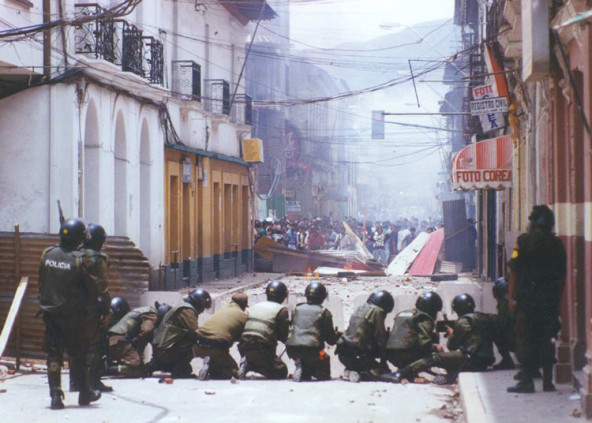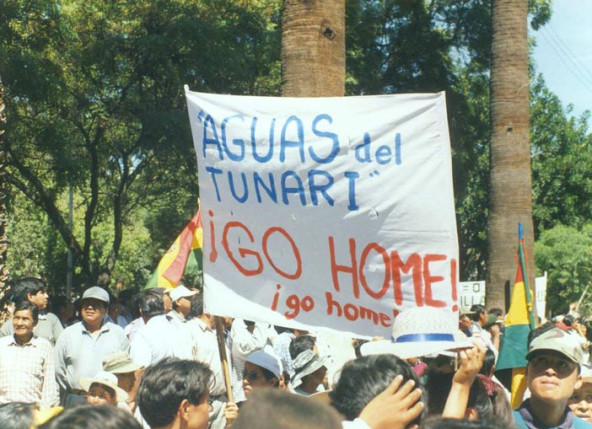 Police and protesters face off in Cochabamba, Bolivia, in 2000. (Photo by Thomas Kruse)
Police and protesters face off in Cochabamba, Bolivia, in 2000. (Photo by Thomas Kruse)
Progressive political activism in the United States is on the rise. Often it is most vibrant in our local communities, where issues are tangible instead of abstract. In our cities and towns, young people and those new to activism have a chance to make a big difference quickly. In the places where we live, the rigid ideological boundaries that often separate us on bigger stages are less important, and we have a chance to come together as neighbors in a common cause.
But many local problems are still rooted in larger issues. From pollution to police violence, challenges facing our communities are tied to bigger forces, and there are good strategic reasons to connect the dots between the two. Making our fight larger builds our strength. And it helps give national and global struggles their moral authority by showing the real people and places that are impacted by them.
So, how can we make our local activism battles bigger? I have learned and used three basic strategies over 40 years of activism involving very different issues and places. They worked in Bolivia, where I lived for 19 years, with the Water Revolt in the city of Cochabama. They also helped in the small town I now call home, Lockport, New York, with a fight over plans to install facial recognition surveillance cameras in schools.
1. Widen the Narrative
The root power of a strong activism campaign is a strong story. It must be clear, compelling, and accurate. Then it has to link the local story with the bigger picture.
Are you enjoying this article? Read more like this, plus SSIR's full archive of content, when you subscribe.
The Cochabamba story went like this: In the late 1990s, the World Bank coerced Bolivia to privatize Cochabamba’s public water system by making it a condition of aid to expand access to clean water. A subsidiary of the US corporate giant Bechtel took control of the water and raised rates on poor families by double or more overnight. A massive public uprising shut down the city of half a million people, forcing the company to leave. In retaliation, Bechtel sued the people of Cochabamba for $50 million in a World Bank trade court.
The Lockport story is this: In response to shootings, school districts around the country are scrambling to do something about safety. Seeing an opportunity, a Canadian casino security company convinced the Lockport School district to spend more than $2.7 million in technology education funds on a high-tech facial recognition camera system that is unlike any other in the country. It is a waste of education funds that won’t actually make students any safer.
In both these cases the strategy is the same–connect the dots between the story on the ground and the larger actors and issues involved:
- Is there a corporation or larger organization driving decisions behind the scenes?
- What state or federal laws influence the local issue?
- Does the local battle reflect national or even global debates?
Make the answers to these questions a central part of your narrative.
2. Widen Attention
Next, that story needs to get picked up by widely distributed media outlets as something more significant than just one community’s battle. If it is a good story with larger implications, that doesn’t take much:
- Find journalists reporting on your issue and share your research with them.
- Connect journalists with local residents who can serve as reliable sources in their articles.
- Write articles yourself for publications that reach audiences outside your local community.
In Bolivia, I helped make the local story a global one by writing about it in publications far beyond Cochabamba, such as the San Francisco Chronicle, In These Times, and the Democracy Center’s global email newsletter. That writing drew attention from other journalists interested in the emerging globalization issue and led to reporting by the The New Yorker and PBS, and several documentaries. All this cemented the Water Revolt as a global story.
On the Lockport surveillance cameras, I began by writing about the issue several times in our local daily newspaper. I used those articles to convince a reporter for the Buffalo News that it was a good regional story, and his piece then drew national interest from The Intercept, the Washington Post, and NPR. A story that had begun strictly local had become big.
Cochabamba, Bolivia, in 2000. (Photo by Thomas Kruse)"> Protesters in Cochabamba, Bolivia, in 2000. (Photo by Thomas Kruse)
Protesters in Cochabamba, Bolivia, in 2000. (Photo by Thomas Kruse)
Getting this kind of larger coverage builds your power locally as well because it puts local officials under broader scrutiny that makes them nervous.
3. Widen Your Alliances
National and global advocacy groups need local stories to infuse their actions with authenticity and authority. You can help their mission—and your local effort—by forming alliances with them. Keep in mind that these are busy people with limited resources, so focus on:
- Finding organizations that align with your issue.
- Reaching out to individuals within those organizations who have demonstrated an interest in your issue. You need internal advocates like these to push your story up the priority list.
- Sharing a concise and compelling summary of your story so potential allies can effortlessly see if it's the right fit for their advocacy efforts.
In the case of the Cochabamba Water Revolt, the groups based in Bolivia found terrific allies in the Institute for Policy Studies, the Council of Canadians, Public Citizen, Earth Justice, and others. Their work was essential to mounting the campaigns that targeted the global players such as the World Bank and Bechtel.
In Lockport, the fight against the surveillance cameras won strong support from the New York Civil Liberties Union (NYCLU). The organization brought in legal expertise and connections to state education authorities. It also filed Freedom of Information Act requests that documented the shady dealings behind the plan.
Victories and Questions
The Water Revolt ended in not just one victory, but two. First, Bolivians kicked out Bechtel, and the global solidarity campaign afterwards forced the corporation to drop its $50 million legal case for a token payment of 30 cents.
The jury on Lockport is still out. District officials had already finalized their plan to buy the cameras by the time I and others discovered it. The New York State Education Department, however, has warned the district not to bring the system online until officials address the huge student privacy issues involved, and Lockport has become a national cautionary tale about false school security.
These two very different stories of local activism offer good, practical lessons about how to connect the dots between local, national, and global fights. These same insights can be applied to climate change in the US, corporate environmental destruction in Latin America, and other urgent battles. To rephrase an old slogan: Act locally but make that struggle part of the bigger one as well.
Support SSIR’s coverage of cross-sector solutions to global challenges.
Help us further the reach of innovative ideas. Donate today.
Read more stories by Jim Shultz.

